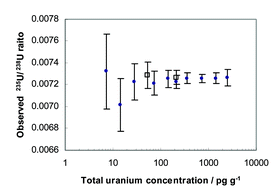Isotope amount ratio measurements by ICP-MS: aspects of software induced measurement bias and non-linearity
Abstract
The effect of a post-acquisition software induced bias on the measurement of the 235U/238U isotope amount ratio in the reference material IRMM-184 was studied. The total uranium concentration ranged from 7 to 2500 pg g−1 [80 (235U) to 3 500
500 000 (238U) counts per second], thus covering the entire pulse counting range of the ICP-MS instrument. The bias for the measured ratio increases with decreasing count rate, and it is mostly governed by the count rate of the 235U isotope. Blocking the data into large subgroups is one way of reducing the effects of the bias; however, a decreased number of blocks is accompanied by an increased scattering of the standard uncertainty. Using a more laborious, manual data evaluation procedure of a less processed raw measurement signal not only solves the problem, it also increases the linear measurement range by at least ten times. At the lowest concentration, 7 pg g−1 total uranium concentration, the combined uncertainty of the observed ratio was less than 5%
(k
= 2).
000 (238U) counts per second], thus covering the entire pulse counting range of the ICP-MS instrument. The bias for the measured ratio increases with decreasing count rate, and it is mostly governed by the count rate of the 235U isotope. Blocking the data into large subgroups is one way of reducing the effects of the bias; however, a decreased number of blocks is accompanied by an increased scattering of the standard uncertainty. Using a more laborious, manual data evaluation procedure of a less processed raw measurement signal not only solves the problem, it also increases the linear measurement range by at least ten times. At the lowest concentration, 7 pg g−1 total uranium concentration, the combined uncertainty of the observed ratio was less than 5%
(k
= 2).


 Please wait while we load your content...
Please wait while we load your content...